
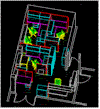
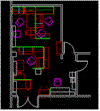

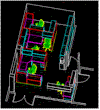
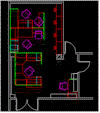

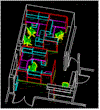
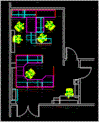

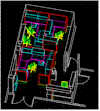
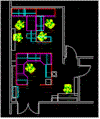

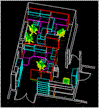
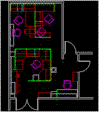
Alternate Office Layouts
In addition to simple ergonomic interventions, plans for more extensive intervention using systems furniture were developed and evaluated with the subject. The resulting layouts emphasized office characteristics which workers often find desirable, including greater privacy, increased work surface, increased storage, and better utilization of space. Additionally, three-dimensional layouts were created to assist the office worker in visualizing the different plans.
| 3d rendering | 3d hidden line | plan view | ||
 |
 |
 |
Current layout | |
 |
 |
 |
Scenario 1 | |
 |
 |
 |
Scenario 2 | |
 |
 |
 |
Scenario 3 | |
 |
 |
 |
Scenario 4 |
Office scenario 1 includes four 4-drawer lateral files with top shelves to organize the materials which clutter the office. This results in a smaller cubicle for the subject than other layouts, however she would still receive more work surface than she has at present. This layout has other problems beside less space, including reduced privacy and longer distance to the main entrance for our subject. This type of layout would be more suitable for an office secretary who must keep track of the coming and going of others within the office. Scenario 2 offers more privacy and work surface area, however when evaluating the scenario, the subject complained of having to walk farther to open the code-locked entry for visitors. This problem could be solved through the use of a remotely operable door lock.
Scenario 3 and 4 are very similar and are the layouts chosen by the research subject. Upon close inspection, scenario 4 offers clear benefits over 3 in increased utilization of existing wall space, accommodation of more original furniture elements into the space, and increased privacy from people looking in through the entry door quarter window lites. Conceivably, the best features of scenario 1 and scenario 4 could be combined to some degree in a single plan. This is our final recommendation for an office layout.
R.P.